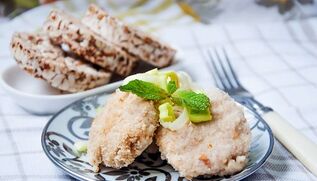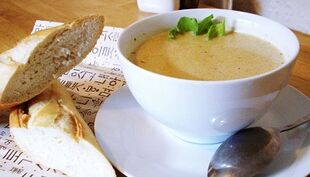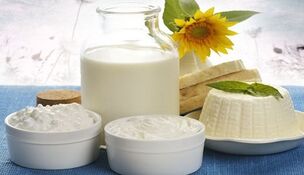
Pancreatitis is a serious pancreatic disease characterized by impaired production of digestive enzymes. The main symptoms of the disease are pain after eating in the left or right hypochondria, heartburn, nausea, vomiting and stomach discomfort.
The key to treating pancreatitis is strict adherence to dietary recommendations. After all, the disease often develops due to poor lifestyle, high consumption of alcohol and "spam" food.
Diet for pancreatitis helps patients reduce pain during exacerbations and add a remission stage. In the case of acute and chronic pancreatitis, the diet is different, but it still has some similarities. Let’s talk about them.
General diet rules for pancreatitis
The main requirement of the diet is to increase the amount of protein consumed and reduce the amount of fat and carbohydrates in the main diet (if possible, they should be completely eliminated). In particular, you should give up granular sugar because it contains 99% carbohydrates.
Fat, which is high in coarse fiber, should disappear completely from the lives of patients with pancreatitis. After all, they put a heavy load on the pancreas, which causes the body to start producing very large amounts of digestive enzymes, which is dangerous in this disease and can lead to serious complications.
Doctors recommend that all patients with pancreatitis take vitamin complexes to help fill the vitamin and mineral deficiencies in the body that often result from a restricted diet.

Meals should be scheduled at the same time.
Eat 5-6 times a day in small portions to avoid excessive pancreatic stress and overeating.
Diet for acute pancreatitis
Acute pancreatitis usually presents with sudden sharp pain in the stomach pit. The pain is unbearable, so it forces a person to call an ambulance. The diet for acute pancreatitis until the doctor arrives is "zero". By no means should you eat food. Neither "easy" nor "hard".
It is allowed to drink still mineral water, but not more than 3 glasses, until the doctor's appointment. And they are allowed to drink only if the urination process is normal.
Acute pancreatitis is only treated in hospital. Fasting is given for the first two days. Only now is it possible to drink rosehip broth together with mineral water. The total amount of fluid consumed should not exceed 5 glasses per day.
On the third day of treatment, the patient is allowed to eat fresh, low-calorie foods that do not contain substances that irritate the pancreas and increase secretion.
When the main symptoms subside, the pancreatic pancreatitis diet lasts for one to two months. During this time, you should opt out altogether:
- fried and fatty foods; buns and cakes;
- pickles and smoked foods;
- pickles and preserves;
- spicy and sweet;
- onions and garlic;
- alcoholic beverages;
- fatty meats and fish;
- sausages.
All foods must be cooked. They should be boiled in water or steamed. Do not use oil, salt and spices during cooking.

The patient is only allowed to eat food that is warm and grated. Before going to bed, it is recommended to use laxative fermented milk products - kefir, fermented fried milk.
Diet duration from 6 to 12 months. The future of a person depends on how he will abide by it. If all dietary recommendations are not followed, the disease can take a chronic form and the patient will have to be treated for life.
Diet for remission chronic pancreatitis
The diet for chronic pancreatitis is slightly different from the diet above. In this case, the patient's diet expands significantly, but only in the remission phase. During an exacerbation period, the diet is completely different, but about that later.
In the case of chronic pancreatitis, the consumption of proteins that should practically exceed the daily norm is allowed, as well as the consumption of carbohydrates (sugar, honey, pastries, pastries, etc. ).
Foods that irritate the pancreas (hot spices, high salt, alcohol, etc. ) are a restriction.
The patient's diet should also be partial. The number of meals is from 4 to 6 times. The food served should be warm. You do not need to grind before taking food.
Meat and fish products should not be high in fat, otherwise it can lead to liver degeneration, which is quite common in chronic pancreatitis. Curd has a lot of useful substances, so it just has to be in the patient’s diet. However, you can only eat homemade curd, but not very fatty. It is forbidden to eat curd in the shop.
If a person cannot give up bread, it is recommended to use yesterday's pastries or crackers (only from gray or black bread) during the meal. You can also eat pastries and pastries, but in limited quantities (no more than one serving per day).
In pancreatitis, it is not advisable to drink whole milk because it is poorly digested. It can be added to teas or used to make flakes and soups. Even if the patient tolerates the milk well, it should not be taken in large quantities. The maximum dose is 200 ml.

Fermented dairy products are very beneficial for people with chronic pancreatitis. Even cheese that is on the list of prohibited foods in other stages of the disease can be consumed during remission, but not in large quantities and if you feel well. The cheese must not be very salty or greasy.
Eggs should not be eaten healthy. The patient's diet can only contain egg white. It can be used to steam omelettes or added to soups.
The patient's diet should not be high in fat (maximum 70 g per day). In addition, most of them should consist of vegetable fats. They are better digested and do not burden the pancreas.
Diet for exacerbation of chronic pancreatitis
The diet for pancreatitis of the pancreas during exacerbation is the same as for the acute form of the disease. The patient is given a fast and is allowed to eat fresh and low-fat food in small amounts when positive dynamics begin.
If the health does not deteriorate, the patient menu gradually expands. After 2-3 months, a person can eat in the same way as in the remission phase.
Remember, this is only an approximate diet for pancreatitis. For a complete list of permitted and prohibited products, consult your doctor. Only he will be able to develop a proper diet according to your health condition.
















































































